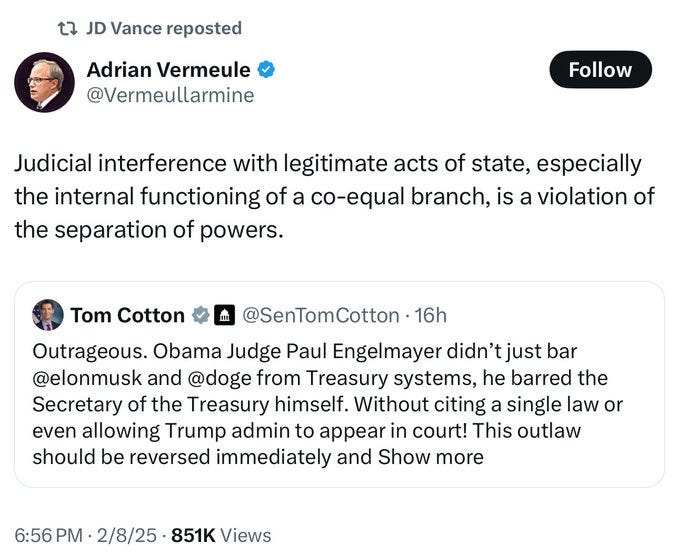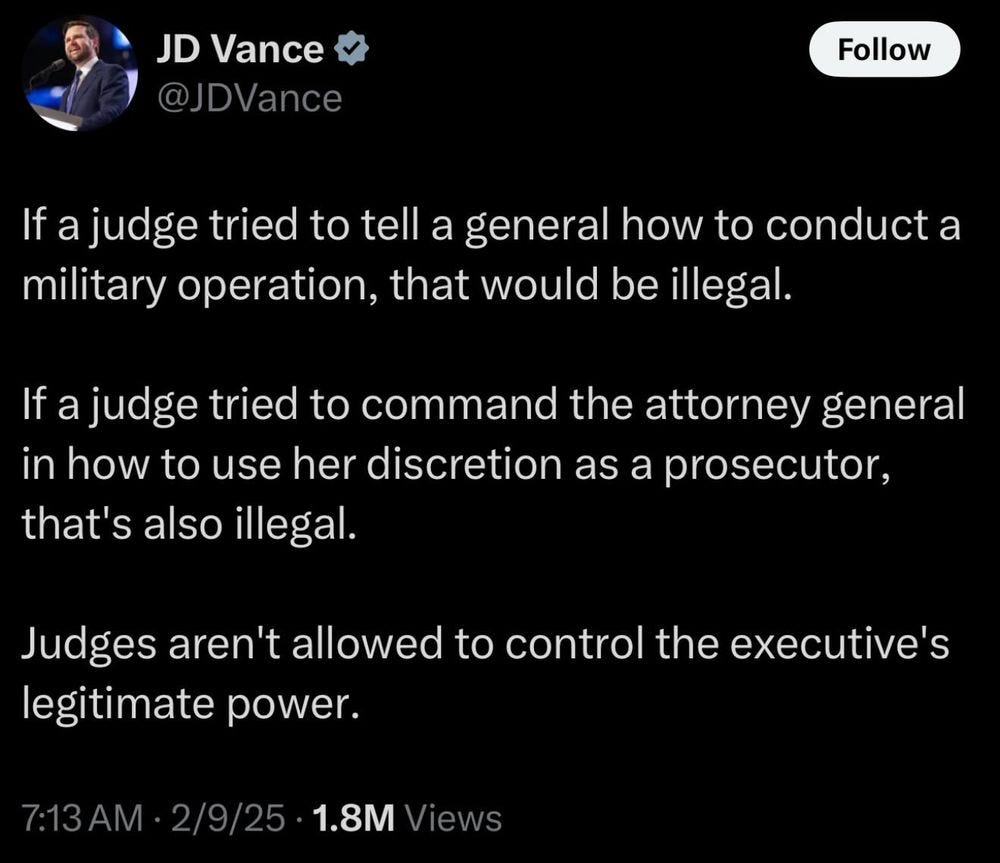It’s tariff week again. Trump stopped the production of pennies; seized control of the Kennedy Center; bleated mean things at Taylor Swift; and called his pardon of the J6 rioters “a great thing for humanity”.1
But there are actually some important things we need to discuss today, like this: “Vance and Musk question the authority of the courts as Trump faces pushback.”
Over the past 24 hours, officials ranging from billionaire Elon Musk to Vice President JD Vance have not only criticized a federal judge’s decision early Saturday that blocks Musk’s Department of Government Efficiency from accessing Treasury Department records, but have also attacked the legitimacy of judicial oversight, a fundamental pillar of American democracy, which is based on the separation of powers.
And, of course: “Republicans, who have largely stood in lockstep behind the president since he was sworn in for a second term, did so again on Sunday.”
Happy Monday.
The knee-bending by billionaire media moguls and the enshittification of social media by the broligarchs has transformed the media landscape... and made independent outlets like Substack more vital than ever.
To the Contrary is a reader-supported publication. You may disagree with me from time to time (and I expect you will, because I’m not promising you a safe space here). But I’ll always try to give it to you straight, sober, sane — with a dash of snark.
Please consider supporting us.
To receive new posts — and the new podcast we launched Sunday— consider becoming a free or paid subscriber. (And I’m immensely grateful for your generous support.)
“Let him enforce it”
Historians doubt that President Andrew Jackson actually said: “[Chief Justice] John Marshall has made his decision, now let him enforce it”.
But since it has now become one of MAGA’s favorite quotes, some brief context seems warranted. Jackson’s refusal to enforce the Supreme Court’s 1832 ruling in Worcester v. Georgia (which involved the rights of the Cherokee) eventually led to the tribe’s forcible removal and the inhumanity of the “Trail of Tears”2 —- during which approximately 100,000 Native Americans were forced from their homes, and as many as 15,000 died during the westward death march.
**
As we know, both Trump and JD Vance are big fans of Andrew Jackson. During his first term, Trump hung Old Hickory’s portrait in the Oval Office; while Vance cites Jackson as a reason to defy the Supreme Court. Back in 2021, Vance told an interviewer.
“I think Trump is going to run again in 2024,” [Vance] said. “I think that what Trump should do, if I was giving him one piece of advice: Fire every single midlevel bureaucrat, every civil servant in the administrative state, replace them with our people.”
“And when the courts stop you,” he went on, “stand before the country, and say—” he quoted Andrew Jackson, giving a challenge to the entire constitutional order—“the chief justice has made his ruling. Now let him enforce it.”“We are in a late republican period,” Vance said later, evoking the common New Right view of America as Rome awaiting its Caesar. “If we’re going to push back against it, we’re going to have to get pretty wild, and pretty far out there, and go in directions that a lot of conservatives right now are uncomfortable with.”
**
Fast-forward to this weekend, where the theoretical is about to become very real. One MAGA influencer after another explicitly rejected the idea of judicial review of executive decisions. The chorus began with complaints from Senator Tom Cotton and right-wing legal schola Adrian Vermeule.
Uh, no. As Professor Steve Vladeck, pointed out: “Just to say the quiet part out loud, the point of having unelected judges in a democracy is so that *whether* acts of state are ‘legitimate’ can be decided by someone other than the people who are undertaking them. Vermeule knows this, of course. So does Vance.”
But Vance not only reposted Vermeule’s post, he doubled down on Sunday.
“This tweet seems to presage the administration ignoring court orders,” noted Jonathan Lemire, “and setting up a Constitutional crisis.”
Well, yes.
And lest there is any doubt about Trump 2.0’s intention to attack the judiciary, Co-President Musk weighed in, calling for the impeachment of the judge who had blocked DOGE from Treasury systems access. Musk posted on X that Judge Engelmayer was "A corrupt judge protecting corruption," adding, "he needs to be impeached NOW!"
He had some other (wildly unconstitutional ideas) as well:
So, who had a Constitutional Crisis on their bingo cards, other than absolutely everyone?
**
I discussed this with David French yesterday on our first ‘To the Contrary Podcast”. What happens if Trump defies the courts? What if the Court issues an order and Trump just ignores it? Who enforces the law? And, at that point, what does the law even mean?
French cited a chilling new piece by Bob Bauer and Jack Goldsmith in which they warned that Trump may be “seeking to effectuate radical constitutional change.”
Specifically, Goldsmith and Bauer argue, that the Trump administration may be attempting “to instill fear in the Supreme Court that the presidency is prepared to resort to outright defiance of its decisions.”
In other words, they are trying to send a message to the justices: Nice Rule of Law you got there. It’d really be a shame if we had to expose the fact that it was all really just a bluff.
Korematsu 2.0?
A bit of history mixed with speculation.
First the history: In 1944, SCOTUS handed down Korematsu v. United States, 323 U.S. 214 (1944), upholding the internment of Japanese Americans who lived in the West Coast Military Area during World War II.
Alongside decisions like Dred Scott and Plessy v Ferguson, the decision is remembered as "a stain on American jurisprudence,” and one of the ghastliest Supreme Court decisions of all time. It has been described as "an odious and discredited artifact of popular bigotry" — and it was (seemingly) repudiated by Chief Justice John Roberts in 2018 in the Court’s decision in Trump v. Hawaii.3
I bring up Korematsu, because the Supreme Court is very likely to have to make another decision about internment and camps and presidential authority. And, while the legal issues will be different, the historical rhyme will be unmistakable.
**
ICYMI: Trump is planning to create a massive detention camp for migrants at Gitmo, the place where we put al-Qaeda terrorists.
The move overflows with questions — about logistics, the law, the humanity — and lawsuits are inevitable. Immigrants’ rights advocates sent a letter to the Administration demanding access to the migrants and denouncing the camps.
“The government cannot attempt to subvert the statutory and constitutional rights afforded to these noncitizens in the United States by transferring them to an offshore prison and holding them incommunicado without access to counsel or any means of contact with the outside world,” the letter declared.
Lee Gelernt, Deputy Director of the Immigrants’ Rights Project at the American Civil Liberties Union said: “It is unlawful for our government to use Guantánamo as a legal black hole, yet that is exactly what the Trump administration is doing.”
But here we go….
Trump to prepare facility at Guantanamo for 30,000 migrants | Reuters
The jail has long been condemned by human rights groups for indefinite detention and came to symbolize the early excesses the U.S. “war on terror” because of harsh interrogation methods that critics say amounted to torture.
The facility for migrants is separate from the detention center on the base….
Migrant flight lands in Guantanamo Bay as legal questions swirl around Trump plans | CNN Politics
“They’d be pushing the limits of where the (Immigration and Nationality Act) applies,” said a former Homeland Security official. Immigration law applies to the United States, and it’s unclear what would happen to those moved out of the country only to be held in detention elsewhere.
The source familiar with the plan said questions like how long the migrants can legally be held there, and what their rights would be while detained, are still unanswered. It is also unclear whether the migrants will have any access to legal or social services while detained at the base….
At its maximum capacity, the center can hold less than 200 people, underscoring how big of a lift this will be. Sources familiar with the planning say the massive undertaking is expected to take 30 days.
Discussions have also ramped up between private contractors and the government to build several tent facilities to hold 30,000 people, according to a source familiar with the planning. The facilities are expected to hold single adults. They are expected to be transported to Guantanamo Bay on military flights before they’re repatriated to their countries of origin.
**
Exit take: There are several possible outcomes here, but I want to focus on two of them: (1) The Supreme Court’s conservative majority will uphold the Gitmo camps, in a decision that would be instantly compared to Korematsu. (2) The Court rules that Trump’s actions were, in fact, illegal and unconstitutional; but Trump decides to ignore the ruling.
Which is worse? Discuss amongst yourselves…
Monday dogs
Rambles in the woods.
Indian removal was Jackson's top legislative priority upon taking office….
According to historian Roxanne Dunbar-Ortiz, Jackson's intentions were outwardly violent. Dunbar-Ortiz claims that Jackson believed in "bleeding enemies to give them their senses" on his quest to "serve the goal of U.S. expansion". According to her, American Indians presented an obstacle to the fulfillment of Manifest Destiny, in his mind. Throughout his military career, according to historian Amy H. Sturgis, "Jackson earned and emphasized his reputation as an 'Indian fighter', a man who believed creating fear in the native population was more desirable than cultivating friendship". In a message to Congress on the eve of Indian Removal, December 6, 1830, Jackson wrote that removal "will relieve the whole State of Mississippi and the western part of Alabama of Indian occupancy, and enable those States to advance rapidly in population, wealth, and power. It will separate the Indians from immediate contact with settlements of whites." In this way, Sturgis has argued that Jackson demarcated the Indian population as an "obstacle" to national success.
Trump v. Hawaii upheld Trump’s revised Muslim travel ban.
In dissent, Justice Sonia Sotomayor wrote that the decision "redeploys the same dangerous logic underlying Korematsu and merely replaces one gravely wrong decision with another." Responding to her dissent, Roberts wrote: "Korematsu has nothing to do with this case. The forcible relocation of U.S. citizens to concentration camps, solely and explicitly on the basis of race, is objectively unlawful and outside the scope of Presidential authority." Legal scholars differ as to whether this statement actually overturned Korematsu or was merely a "disapproving dictum" of it.











The short answer is that we will be faced with a choice. We will have to be even more ferocious in our opposition. National protest, general strikes, civil disobedience. The grassroots is already having an impact on elected Democrats and we are giving them a spine. We have to keep pushing them every day to keep that spine. So everyone should be calling their senators and reps and telling them to use all their powers to deny, obstruct and delay against Musk/Trump.
The tide is turning and that is why Musk and Vance are talking about ignoring rulings. Now is not the time to back down, but instead it is time to ramp up. I won't go without a fight and neither should anyone else.
I'm on record - I'll reiterate here - that, ultimately, nothing will stand in Trump's way. The Republican Senators, as expected, have immediately capitulated and will rubber stamp Trump's unqualified nominations. The courts will battle for a while but, ultimately, they'll roll over. It won't matter, because Trump will do what he likes, regardless. This is the situation expected from the second coming of Trump. And too many were either in favor of it or too ambivalent to care.